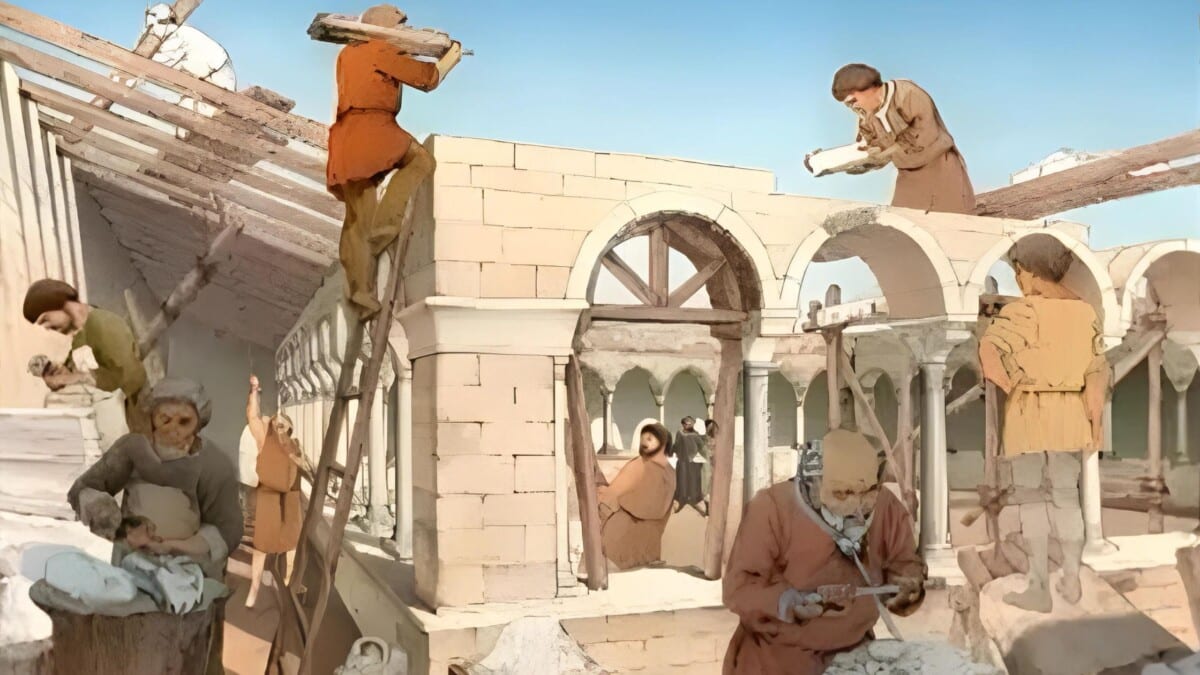
Natale’s obituary mentioned our family’s long connection to the church, but digging deeper didn’t yield much until we looked into Campi Albareto. Its size and history, especially its old cemetery, hint at a lineage stretching back centuries. It seems our ancestors might have been a group of skilled craftsmen and their families, possibly known as the Maestri Comacine. The Via Francigena, an ancient pilgrimage route from Canterbury to Rome, adds weight to this theory, linking the Campi to the Maestri Comacine.
We learned that in Italy, graves are leased for 75 years, and families can decide whether to renew. When leases expire, bones are moved to a common grave to conserve space. That’s why I couldn’t find some expected names, like Lazzardo Maestri. It’s also said that inheritance rights are preserved in Italy, which might explain why the Maestri in the village were cautious about meeting us.
Even the priest wasn’t available and Maria didn’t find any Maestri cousins, many graves and streets in Borgo Val di Taro carry the Maestri name. These artisans, known as the Maestri Comacini, were more than just builders—they were architects, painters, and engineers who made a lasting impact on history. Despite their significant role since the Middle Ages, their contributions were often overlooked by historians.
But make no mistake, the Cathedral Builders were pioneers. They worked with various stones found around Lake Como, honing their skills in extracting and manipulating materials. This specialization attracted artists from far and wide, creating a hub of creativity in the region.
Their influence wasn’t confined to Italy. Maestri Comacine guild were made free and independent of medieval restraints and set at liberty to travel about to all kingdoms of Europe in the 11th century.
Like nomads of construction, they traveled across Europe, sharing their techniques and ideas. From Burgundy to the Rhine Valley, their craftsmanship left a lasting impression, shaping the architectural landscape of cities like Genoa, Salzburg, and St. Petersburg.
This slideshow is a history of the Maestri family name in Italy
Despite their individual talents, the Maestri Comacini valued unity above all else. They operated as a collective, known simply as “brothers,” emphasizing collaboration over personal glory. This spirit of solidarity allowed them to work efficiently, delivering projects with remarkable speed and precision.
-
MAESTRI FAMILY
NORTH ITALY 1700 -
ENTIRE FAMILY
EUROPE & AMERICA -
DALE FAMILY
FRANCE 1500 – 1600
But their legacy goes beyond construction. The Maestri Comacini were entrepreneurs, merchants, and even diplomats. They formed strategic alliances with churches, courts, and fellow artists, cementing their influence across Europe.

The square and compasses stand out as prominent symbols within Freemasonry fraternity.
While the Freemasons exact origins are uncertain, they are thought to have emerged from the medieval stonemasons’ guilds, like the Maestri Comacini.
The Maestri Comacini, played a significant role in the development of architectural and building practices during the Middle Ages.
Their connection to their homeland was strong, yet they embraced the world. They sent money back home, exchanged technical knowledge, and formed powerful alliances through marriages. In essence, they laid the foundation for a network of families that would shape the future of European art and architecture.
Some even speculate that the Maestri Comacini were the ancestors of Freemasonry, drawing parallels between their rituals and those of the secret society. Regardless, their art is filled with symbolism, from intricate patterns to pagan motifs, adding layers of mystery to their work.
We had the opportunity to visit the Basilica of Saint Francis in Assisi, Italy in 2023. Pope Gregory IX laid the first stone was on July 17, 1228, the day after the canonization of St. Francis, in the place previously used for executions and burials of criminals. According to tradition, Francis himself, on his deathbed, indicated this spot to his companions as the place for his burial.
The Basilica of Saint Francis was constructed by the Maestri Comacini, not far from the cathedral we found the “Lodge of the Maestri Comacini” where the guild’s craftsmen lived during the construction of the church. We spend some time speaking with the business owner that occupies the build today – a jeweler.
So, the next time you admire the Basilica of Sant’ Abbondio or stroll along the shores of Lake Como, remember the hands that built them. Behind every stone, every carving, lies the legacy of the Maestri Comacini, whose craftsmanship continues to inspire awe and wonder to this day.































